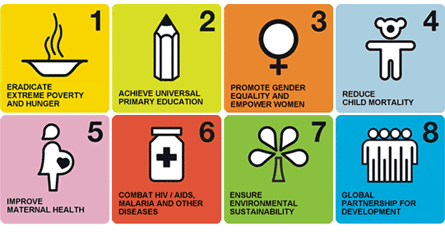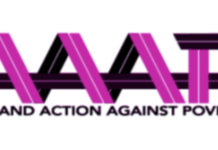Earlier this week, the UN published the 2015 version of its Millennium Development Goals report. Kicking off in 2000, the MDGs were a UN-led effort to mobilize development agencies, donors and aid-recipient governments around eight clear development goals. They expire this year and the 2015 annual report will be the last. So, the report’s authors were in a celebratory mood, eager to highlight the MDGs’ achievements with some impressive numbers. This is, however, no time to party.
The UN’s headline statistic is that the number of people living in extreme poverty has fallen from 1.9 billion in 1990 to 836 million this year, a reduction of 56% (the goal of halving poverty was actually met in 2010). That’s a lot less poor people, a big achievement especially when you consider that the global population increased by about one-third during this time. Dig a little deeper into the figures and you will find that this statistic is dominated by one country, China, which accounts for roughly two-thirds of the poverty reduction (a staggering 680 million people are estimated to have been lifted out of extreme poverty). Other, less spectacular, but still significant gains can be found elsewhere in Asia and in North Africa. Conversely, the gains in sub-Saharan Africa have been modest with the percentage of extreme poor standing at just 86% of what it was in 1990, meaning that in nominal terms, the number of African poor has actually risen. In the Caribbean, the situation is even worse with extreme poverty having risen by 13%.
The obvious conclusion to be drawn here is that poverty reduction is uneven and the UN openly admits this. What the UN is less open about, though, is the extent to which it and other, mainly Western, development actors can claim credit for the global gains. The fact is that neither the UN nor other leading development actors of donors have played a significant part in China’s poverty reduction. Rather – and this may be an uncomfortable truth for many Daily Blog readers – economic globalization has been the driving force behind this poverty reduction statistic with manufacturing jobs providing regular income to millions of poor rural families. Without the China factor, the heralded poverty reduction target would not come close to being met. It is even a stretch for MDG contributors to claim credit for the non-China achievements, which are dominated by South-East Asia and North Africa; regions which have received little development assistance compared with places where extreme poverty remains a stubborn problem.
The MDGs also suffer from a measurement problem. By this I mean, of course, that the data behind some of the numbers if questionable. The UN report admits this flaw, all the while quoting fresh statistics on every page, and I know the sorts of problems they’re referring to (I could tell many tales about some of the UN data collection exercises I have been involved with or share anecdotes such as the Sudanese Education official who told me that he would mark students’ illegible answers as correct on MDG monitoring exams). But, I’m also talking about the problems created by measuring the wrong things. The UN is correct when it says, to quote the 2015 report, that “what gets measured gets done” and many would argue that the success of the MDGs has been in the focus brought about by simple, clear measurements. This catch-phrase, however, needs to be heavily balanced by another cliché, “be careful what you wish for”. Nowhere can this problem be more clearly seen than in the MDG Goal 2; achievement of universal primary education. This goal has not been met (only 91% of kids get a primary school education, up from 83% in 2000), but gains have been made in all global regions, most notably in sub-Saharan Africa (where enrolment has risen from 54% to 78%). It doesn’t take a development expert, however, to understand that school attendance is meaningless unless kids in school actually learn something. The reality is that many countries, notably those who have been given development aid for education, have focused on getting kids into school as an end goal, rather than focusing on improvements in educational achievement. They have been doing what gets measured and, as a result, have largely kept their donors happy. But, in real development terms, what is the point? Of course, the MDG creators were not silly enough to ignore this issue entirely and included a measure on increased literacy. This is also a poor thing to measure because literacy (as it is narrowly defined and tested in most developing countries) is not an especially useful thing compared to the broader skill of reading comprehension. But, even using this measure, the results are less than outstanding (only a 7% gain in literacy rates compared with an 11% gain in enrolment rates) and in some countries, the results have been counter-productive. In other words, although a larger number of kids are going to school, a lower proportion of them are actually learning to read and write (in Tanzania, for example, enrolment grew from 51% to 85% but literacy rates actually fell); a sad, but hardly surprising result when you consider that the focus has been on cramming kids into schools, rather than in improving the quality of the education they receive.
The measurement problem is greater in those MDGs where, by nature of the issue involved, there is a more complex relationship between the development action (e.g. building a classroom) and the development outcome (e.g. a well-educated kid). The health-related MDGs can more convincingly claim genuine success because, for example, the link between a measles vaccination and a reduction in measles deaths is so direct (although anti-vaxers would have another spin on this, I’m sure). Indeed, successes in health-related MDGs are worth celebrating! It’s also only fair to point out that many health-care gains have been made in tough parts of the world where development actors are busily doing their thing. UN technocrats, aid workers and the donors that fund their work can all claim credit for saving the lives of many people; especially children and mothers.
But, this brings me to my biggest concern about the whole MDG thing, which is the reality that the easy work has been done and the most difficult work yet remains. Populations in conflict zones remain especially vulnerable and provide a context which neither the forces of globalization or UN-led development efforts can penetrate. The populations of isolated countries, whether land-locked or small islands, are similarly at risk. In many such countries, extreme poverty is rising not falling. Perhaps most notably, the world’s refugee population is at historic levels, driven by intensifying violence and poverty in certain parts of the world. It is my view that globalisation’s success in poverty reduction has reached its peak and the UN’s contribution to poverty reduction has been considerably more modest than their reports let on. Quite simply, a new formula is needed if success is to be sustained. Enter the Sustainable Development Goals; which the UN has proposed as the MDGs’ successor.
The SDG dialogue started off well, displaying a cognizance that poverty is not simply about lack of money, clean water or medicine, but that it is rooted in global economic paradigms, climate change and bad governments. Such issues need to be tackled and to do so, the UN needs to not only harness funding from rich-world governments, but mobilise them around such challenges as global trade inequalities, government corruption, climate change and protracted conflicts. But, this was quite clearly too hard. Rich-world governments have proven content to throw money towards the MDGs, but what is really needed is a change in their many counter-developmental behaviours. The United States, for example, could probably make a far bigger contribution to ending conflicts by attempting to reduce the global arms trade (starting with its own $10 billion/year arms export industry) than by increasing aid, but which of these is actually more likely to happen? The European Union could have a hugely positive impact on African exports by removing its agricultural subsidies, but that is likewise far from the political reality. The world’s rich countries could permanently save millions from hunger by taking firm action on climate change and we all know how well that is going.
As a result, the SDG project has been watered down considerably. Although it is pleasing to see a greater environmental focus (proposed SDG 14, for example, recognizes the importance of sustainable marine resources), the SDG framework is not fundamentally different from its predecessor. The SDGs also carry a similar rallying cry, that of eliminating extreme poverty completely by 2030. On the face of it, the logic behind this goal is clear, if the MDGs eliminated more than half of extreme poverty, why shouldn’t the SDGs be able to finish the job? Sadly, though, this goal appears wholly unrealistic. Without genuine, holistic efforts to eliminate poverty, it will remain and in 2030 there will be much less to celebrate.






I’d suggest most conflict in the world involves Russian or Chinese made weaponry rather than US. US military hardware tends to be very expensive and us restricted to nation states.
As usual you are wrong. USA has a massive build up of weaponry, and is inciting Russia to fire the first shot so that America can respond and blame Russia,American weaponry is in any country they choose to attack.
A lot of so called enemy have American arsenals .
You make a good point, but forgot to mention Mexico, where cartels do the same things as ISIS but the US doesn’t care.
Or the right wing death squads of Latin America… Or on-going Israeli aggression in Gaza… or any other number of events…
Yeah, or Saudi and Yemen, but I thought we were only talking about when poor countries do it. That’s different from rich countries…right?
Only drug money can buy US guns in poor states, Russia and China capture the low end.
I think the agricultural subsidies of the US, EU and Japan are the biggest obstacle to ending poverty in the global south.
Unequal trade rules in general are the Wests way of taking riches from weaker countries. It’s neo-colonialism.
Comments are closed.